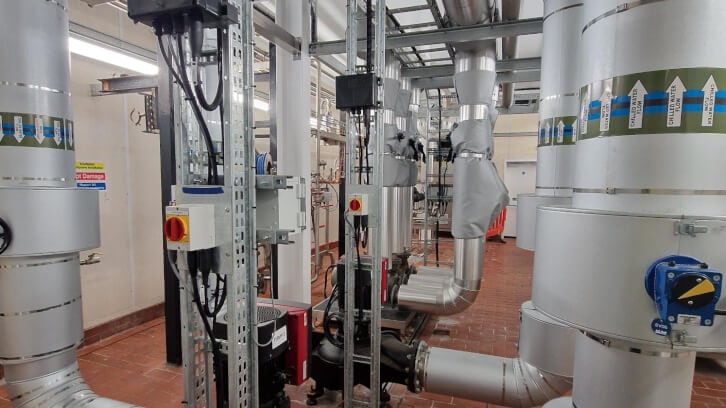One in six pints of milk around the world are estimated to be lost or wasted, with 16% of dairy products discarded globally each year, a good deal of which are lost before they even reach the store – during distribution and also production.
Preventing wastage is a concern for dairy farmers whose bottom-lines are ever-tightened by supermarkets and their customers looking for a cheaper deal. Cooling is a key part of wastage prevention, however, the electricity costs associated are eye watering, with the Agriculture and Horticulture Development Board (AHDB) stating they typically account for one-third of power usage on a dairy farm. As such, it can be hard for farmers to find the balance between adequate cooling, profit and sustainability.
Developing an efficient refrigeration system for First Milk
To help First Milk find this balance when it comes to whey and cream products specifically, J&E Hall was called upon to develop a new refrigeration system at its main site in Haverfordwest, in Wales.
Precise regulation of the water temperature is necessary for everyday processes, which are vital for the successful operation of the dairy.
First Milk’s previous system was outdated, inefficient and struggled to maintain five degrees in the summer months. Cream and whey would sometimes be rejected at delivery due to out of specification temperatures which impacted customer satisfaction. On top of this, one of the co-op’s core focuses is the sustainability and regeneration of the British dairy industry, therefore, First Milk wanted its new plant to keep emissions to a minimum.
“As a co-op with regenerative values, a major factor for First Milk for every new project is its environmental impact,” added Nigel Roberts, chief engineer at First Milk. “Rather than just going for the lowest-cost option for our new chilled water plant, which would likely have a limited lifespan, we were looking to future-proof the site and do the right thing in terms of our climate goals.”
We developed a bespoke ammonia cooling system, which optimises the dairy’s performance, reduces energy use, increases efficiency and ultimately cuts costs. It enables the site to dispatch its products on day of manufacture – no deliveries have been rejected yet since the plant has been in service.* Crucially, it is specifically designed to be climate friendly.
Ammonia is one of one of the most efficient coolants on the market for both high and low temperatures. It has zero environmental impact in terms of Ozone Depletion Potential (ODP) and Global Warming Potential (GWP). Overall, the new system produces around 412 tonnes less CO₂ emissions per annum versus the old plant.
Cooling system specifics
The new refrigeration system’s efficiency and effectiveness is enhanced by a number of innovative solutions, including evaporative condensers which remove excess heat from the HallScrew compressors and a surge vessel station, which delivers liquid ammonia via gravity feed to a falling film water chiller. This allows the plant to cool chilled water from 6.0˚C down to temperatures ranging between 0.5˚C and 1.0˚C, which is necessary for the dairy’s process requirements.
A gravity vessel is utilised to maximise the evaporator surface so that all compressors operate at the same suction pressure, further improving efficiency. HallScrew compressors feature a high efficiency capacity control mechanism even at lower loads, which regulates capacity with a corresponding reduction in power input. Overall, compared with air cooled condensers, an evaporative condenser requires a lower temperature which goes a long way to reducing plant power consumption.
Other efficiency enhancing features include the utilisation of floating head pressure control, which enables adaptation to lower ambient conditions to optimise the plant’s performance. The control regulates pressure by floating it automatically using outside air temperature, reducing the amount of pressure on the compressor during colder months. This type of control can help to cut energy costs in winter especially, as no extra cooling power is needed.
The dairy now has a constant chilled water temperature of 0.5˚C in all ambient conditions, while benefitting from reduced energy bills compared with the old refrigeration system.
Seamless transition
J&E Hall worked closely with First Milk to align the changeover from the old system to the new plant with its annual dairy shutdown. This meant timings were tight – the new plant had to be installed and dry-tested in two days before operations started up again – there was no room for error.
Commenting on the decision behind using J&E Hall, Roberts said the firm's solution met its climate needs and its long term partnership offered reassurance.
“Having worked with our local branch for many years also gave us peace of mind that the maintenance and servicing would be well taken care of,” he added.
“We feel confident that our new chilled water plant will adequately meet the growth and any cooling requirements that new developments on the First Milk site present. The new ammonia system is a safe and sustainable choice for the future.”
*Accurate at time of writing




